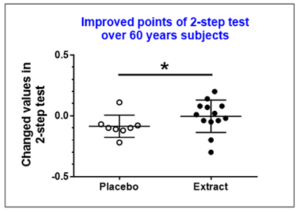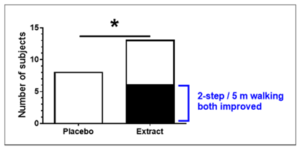Extract of Cistanche tubulosa ameliorates walking ability in locomotive syndrome: Evidence by a Placebo-Controlled, Randomized, Double-Blind Study
A research group in Section of Neuromedical Science, Institute of Natural Medicine, University of Toyama (Dr. Yuna Inada, Dr. Ximeng Yang, Dr, Chihiro Tohda) found that intake of extract of Cistanche tubulosa for 12 weeks improved walking ability in subjects with locomotive syndrome(*)
In an aging society, preventing dysfunction and restoring function of the locomotive organs are necessary for long-term quality of life. Few interventional studies have investigated supplementation for locomotive syndrome. Additionally, very few interventional clinical studies on locomotive syndrome have been performed as placebo-controlled, randomized, double-blind studies. Dr. Tohda’s group previously found that the administration of 30% ethanolic extract of Cistanche tubulosa improved walking ability in a cast-immobilized skeletal muscle atrophy mouse model. Therefore, they conducted a clinical study to evaluate the effects of C. tubulosa (CT) extract on the locomotive syndrome.
Twenty-six subjects with pre-symptomatic or mild locomotive syndrome completed all tests and were analyzed in the study. Analyses of muscle mass and physical activity were performed based on the full analysis set. Intake of CT extract for 12 weeks increased step width (two-step test) and gait speed (5 m walking test) in patients over 60 years old compared with those in a placebo control (p = 0.046). Adverse effects were evaluated by blood tests; no obvious adverse events were observed following the intake of CT extract. In conclusion, this placebo-controlled, randomized, double-blind study demonstrated that treatment with CT extract significantly prevented a decline in walking ability without any notable adverse effects in patients with locomotive syndrome.
This study was published in Nutrients 2021, 13(1), 264, on January 18, 2021.


(※)Locomotive syndrome
Locomotive syndrome was first described by the Japanese Orthopedic Association (JOA) in 2007, and it encompasses a wider range of disabilities than musculoskeletal ambulation disability symptoms. The locomotive system includes muscles, joints, cartilage, and bones that gradually weaken with age or due to other diseases. Factors, such as lack of exercise, a sedentary lifestyle, and inadequate nutrition, also contribute to the progression of locomotive syndrome.

